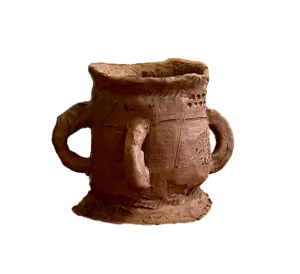 An innovative series of workshops took place at CAST in November 2022, and again in November 2023, developed by Lucy Grant and her learning team in partnership with the Museum of Cornish Life and the new ceramic studio at CAST. The project took as its starting point the fragments of Neolithic pottery in the Museum’s collection. These pots were made from gabbroic clay (clay formed as a result of the weathering and erosion of the stone gabbro) found only in a small area around St Keverne on the Lizard peninsula. With the support of Natural England, a team from CAST and the team from the ceramics studio collected some of the gabbroic clay and brought it back to CAST so that its special properties could be explored.
An innovative series of workshops took place at CAST in November 2022, and again in November 2023, developed by Lucy Grant and her learning team in partnership with the Museum of Cornish Life and the new ceramic studio at CAST. The project took as its starting point the fragments of Neolithic pottery in the Museum’s collection. These pots were made from gabbroic clay (clay formed as a result of the weathering and erosion of the stone gabbro) found only in a small area around St Keverne on the Lizard peninsula. With the support of Natural England, a team from CAST and the team from the ceramics studio collected some of the gabbroic clay and brought it back to CAST so that its special properties could be explored.
In 2022 children from the three Helston primary schools (Parc Eglos, St Michael’s and Nansloe), and a group from Coverack Primary School, each spent a day working with clay and exploring the making of pottery for cooking and storage in Neolithic times. The day-long workshops began with a visit to the Museum of Cornish Life, where Emily Mason, the museum’s Headley Trust Archaeological Finds Intern, introduced examples of locally-found gabbroic pottery. The children then moved back to CAST’s learning studio, where they worked together in small groups with potter Hannah Lawrence to build and decorate their own ‘Neolithic’ coil pots. Each group also spent time in the Brickworks ceramics studio, having a go on the potter’s wheel and making their own small pinch-pots or animals from gabbroic clay.
Ceramicist Rosanna Martin, director of Brickworks, described the experience of the workshop as ‘very special’. ‘The children filled the studio with huge excitement. It was great to be able to share with them the gabbroic clay we had dug from the Lizard just days before. Before anything was made we spent time squidging and squishing the clay in our hands, understanding how it responded to our touch. The clay then led the way and many flurries of making occurred, with decorated pinch pots and animal sculptures emerging.’ The Brickworks session ended with an opportunity for children to try throwing a pot on the wheel.
Contributing to sessions both at the Museum and at CAST, Emily Mason recorded some of the excited comments made by children during the day:
“When I’m older I want to get a job here so I can spend all day teaching children how to make pottery.”
“I’d completely forgotten that this was a school day – I only realised when I looked up and saw that we’re all wearing our uniforms!”

“I told my parents that as we weren’t at school today we wouldn’t be doing any proper learning. But now I realise we’ve been learning loads all day!”
Teachers too expressed their pleasure in the workshop, particularly enjoying links between the museum visit, learning about the historic use of locally found gabbroic clay, and the children’s own hands-on experience of making. One teacher talked about pupils returning to school ‘buzzing after the real-life experience of the potter’s wheel’ and another about the ways in which the different forms of making encouraged the children’s individual creativity and independence.
In 2023 these special workshops were made possible by a Heritage Lottery fund grant. They are part of CAST’s ongoing schools programmes which are supported by the UK Government through the UK Shared Prosperity Fund.




